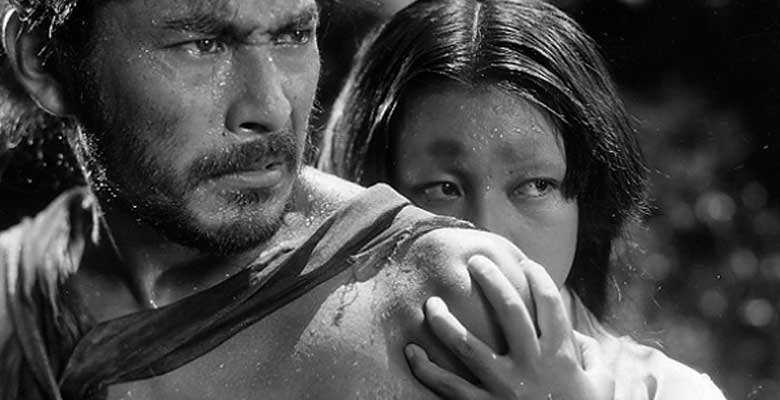HIGH AND LOW: THE BLACK AND WHITE WORLD OF AKIRA KUROSAWA'S NOIR
Image courtesy of tokyoweekender.com
Some of my favorite memories of my childhood came from the time I spent with my Bachan (grandmother), Chieko. And, like all grandmothers, she spoiled me. She’d cook noodle dishes like yakisoba while I would hang out and watch movies until my mom came to pick me up.
I know these visits don’t sound like anything groundbreaking, but somehow they taught me a lot about who I was and who we were. Her food taught me why we cooked the things that we did the way that we did. Bachan would tell me words and phrases in Japanese while she listened to pop music from her youth in the background. But her greatest lessons for the person I grew into as an adult were taught in the TV room.
At first, it was just normal kids’ stuff. Random cartoons that I wanted to watch, nothing crazy. Then, my extended family in Japan started taping and mailing me episodes of popular shows from overseas. Doraemon, Juspion, and Kamen Rider were a few of my staples until I was deemed old enough for something else: Rashomon.
Still from Rashomon
I had never seen anything like it. Something so epic and so beautiful. Something made by people who looked like my family, by people who looked like me. And it was good. Really good. I needed more. I needed to know more.
Bachan made it simple once she realized how much I loved it. I remember her voice like it was yesterday, “Oh, you like Kurosawa?” All I could do was nod my head and wait for the next tape.
By the time I was 18, I was well-versed in Kurosawa and really thought I had seen everything he had to offer from his first film Sanshiro Sugata to 1990’s magical realist masterpiece Dreams. I was wrong.
JAPANESE NOIR
Film noir, or simply ‘dark film’ in French, is defined as ‘a style or genre of cinematographic film marked by a mood of pessimism, fatalism, and menace’ first coined in 1946 by French film critic Nino Fran. The term was originally applied to American thrillers or detective films made between 1944–1954 and the work of directors like Orson Welles, Fritz Lang, and Billy Wilder.’
Most film noirs from this era were simply labeled ‘melodramas’ in Hollywood, noir only being applied in retrospect. But the popularity of these films had a far wider reach, a reach that extended east, straight into the eyes, ears, and minds of a disillusioned post-war Japan.
Japanese noir itself is really no different from its counterparts in America, or anywhere else for that matter. The same existential dread, the same black and white, low-key lighting, the same questionable characters that we’re not 100% sure we should be rooting for. All of it.
‘Hey Mike, how does Kurosawa figure into this?’
Despite his legendary status as a filmmaker amongst cinephiles and filmmakers alike, the majority of the world has only scratched the surface of his filmography.
Films like Rashomon, Seven Samurai, The Hidden Fortress, and Yojimbo may be the most popular of his career that spanned over half a century.Only recently have his films noir been given proper treatment and released via The Criterion Collection in their Japanese Noir section which celebrates a wide array of Japanese noir films from various filmmakers. (Highly recommended.)
What does that mean? It means you can watch them super easily without the tiniest iota of an excuse.
DRUNKEN ANGEL (1948)
Drunken Angel would be Kurosawa’s first foray into the world of noir. He once said, “I am very fond of Georges Simenon and I wanted to do something in his manner.”
Simenon was a Belgian novelist who was famous for his crime novels and the influence of his stories on Drunken Angel, as well as the other 3 pieces I’ve selected, is evident.
The film follows a yakuza named Matsunaga, played wonderfully by frequent Kurosawa collaborator Toshiro Mifune, who has been diagnosed with tuberculosis and is undergoing treatment by Dr. Sanada.
Matsunaga continues his treatment until he finds himself slipping into his old ways of drinking and womanizing when his sworn brother, Okada, is released from prison.
When Matsunaga eventually collapses during a heated dice game, he’s taken to Dr. Sanada’s clinic and, in one evening, his world begins to collapse with Okada pulling the strings.
Watch on The Criterion Channel
STRAY DOG (1949)
The next piece of this “quadrilogy” is Stray Dog.
This time our focus is shifted from inside the criminal underbelly and the yakuza to that of a young homicide detective named Murakami, again played by Toshiro Mifune.
Considered one of the earliest detective films in Japan’s history, as well as a precursor to buddy cop films and police procedurals, Stray Dog focuses on how the tiniest of mistakes can lead to a wave of tragedy, a common trope of noir.
At the beginning of the film, Murakami has his Colt pistol stolen during a trolley ride. After reporting this to his superior, he’s told to conduct an investigation and goes undercover in Tokyo’s backstreets.
The rest of the film is a procedural whodunnit fraught with red herrings as Murakami traces not only his gun’s location, but the atrocities that have been committed as it’s changed hands.
Watch on The Criterion Channel
THE BAD SLEEP WELL (1960)
In his third noir film, we shift perspective again. This time to post-war corporate Japan in Kurosawa’s riff on Hamlet, The Bad Sleep Well.
The film focuses on a character named Koichi Nishi played by, you guessed it, Toshiro Mifune. Nishi falls in love and marries his boss’ daughter, Yoshiko.
During the wedding, one of Nishi’s coworkers, Wada, is arrested during the wedding on suspicions of a kickback scheme. This is the most recent offense in a wave of scandals for the corporation following the suspicious suicide of a senior officer, Furuya, who was used as a scapegoat.
When Wada is released after questioning, he fears retaliation from his corporate overloads and attempts to commit suicide by jumping into an active volcano. His attempt is interrupted by Nishi, who tells him his true identity; the son of Furuya.
Watch it on The Criterion Channel
Rent it on Amazon
HIGH AND LOW (1963)
Finally, we’ve reached what is considered a staple in not only Japanese noir, but noir as a whole, High and Low.
Based on the novel King’s Ransom by Ed McBain, High and Low is part stage play and part police procedural.
We begin in the home of Kingo Gondo, an executive of the Yokohama Shoe Company, played by...say it with me now…MIFUNE!! Gondo had just secretly mortgaged all he owned to leverage a buyout for control of the company. But before he could put his plan in motion, he received a phone call.
His son, Jun, had been kidnapped and the caller demanded a ransom be paid. Just as Gondo agrees to pay the ransom, Jun enters the home. Soon after, another call comes from the kidnappers revealing that they had actually abducted the son of Gondo’s driver.
The rest of the film plays at peak tension while Gondo decides whether or not to pay the ransom and lose his place in the company.
Watch it on The Criterion Channel
EIGA NO AI (LOVE OF MOVIES)
High and Low was definitely the first of this bunch that I saw. I got wind of a screening of it at this tiny little art-house theater in Raleigh, NC. I arrived at the theater, got my ticket, and as I sat down, I found myself thinking of my Bachan, thinking of the smell of her house, of her kitchen. My mind felt 8 years old again.
Through these films, I was transported, not into a fantasy world, but into the past lives of characters that felt real. They were complex beings who were far from what we typically view as ‘heroes’. I saw stories blanketed in darkness with a wide array of characters from yakuza to detectives to businessmen. I saw how the darkness of the world could permeate every fiber of goodness.
More importantly, I saw the good that can be cultivated through representation. I saw the threads that bind us as a species and that the separation we believe to be true based on things like culture, language, and geography is simply a myth.
And I saw it all through the lens of Akira Kurosawa slurping noodles in my Bachan’s living room.
This article was written to encourage further exploration and learning. Most of the hyperlinks included within the text lead to detailed explanations of terms or articles about the cultural impact made by a specific film or director.
Happy reading and hit our contact page if you would like to contribute an article.






